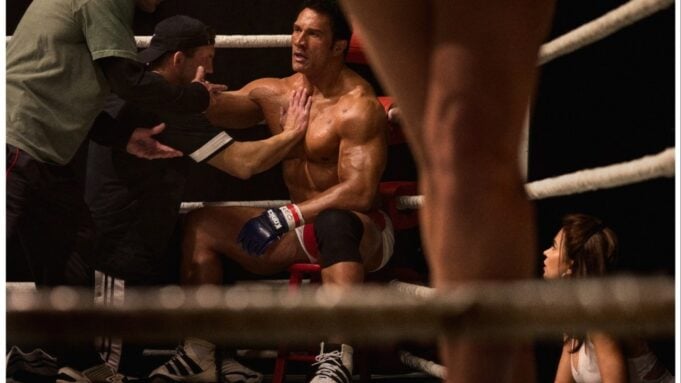In the opening scene of “The Smashing Machine,” Benny Safdie’s bracing, clear-eyed, and laceratingly humane sports biopic, we see grainy staged video footage of Mark Kerr (Dwayne Johnson), the mixed martial arts and Ultimate Fighting Championship star, in his very first amateur bout. Kerr originally won notoriety as a wrestler, and in case anyone has wandered into the movie thinking that it might be about “fake wrestling,” this fight will dispel that delusion: It ends with Kerr crouching on top of his opponent, assaulting him with one merciless bare-knuckle punch after another, reducing his face to a bloody pulp.
As all of this is happening, we hear Kerr’s voice on the soundtrack — it’s a voice that’s disarmingly gentle and sweet — describing, to an interviewer, the high he gets when he’s destroying his opponent in the ring and he can feel that turning-point moment when the other fighter crumples and submits. This makes sense to us, but at the same time it doesn’t sound too far removed from a serial killer’s description of the high he gets from strangling someone to death. “When you win,” says Mark, “nothing else in the world matters.” He’s talking about wrestling, but he’s really talking about violence: the thrill of it, the kill of it.
Mark has a rather striking appearance. With his sharky white teeth and mop of greasy curls, his eyebrows that seem to sink right into his lower forehead, and his so-musclebound-he’s-slightly-hunched-over superhero physique, he could be a parody of the “all-American” god-jock next door. He’s like a gigantic doll — a walking action figure crossed with the Hulk. And it’s not only his look that seems a concoction; he sounds like someone who learned to talk in a self-help seminar. His thoughts come out softly and carefully, with a market-tested civility. (He talks this way even when he’s in his own living room.)
What all this adds up to is that the Mark Kerr we see is a creature of sports showbiz, presentable and polite, with a look engineered to make him a hero, yet what he’s carrying around deep inside him — the thing that makes him a smashing machine — is a rage he scarcely knows what to do with. And that’s where Dwayne Johnson’s revelatory performance begins. Out of the ring, his Mark is affable enough, but if you look closely he’s haunted — a fighter who feeds on his inner brute but is also bizarrely, almost ritualistically detached from it. The pieces of his personality don’t quite fit together. He’s a professional exhibitionist of mayhem who is also, beneath it all, a man who holds everything in.
Johnson, shifting his whole aspect (he seems like a new actor), invests that silent, moody, hidden side of Mark with a quality of mystery. He gives an extraordinary performance, playing Mark Kerr as a gentle giant with demons that will not speak their name, yet the audience can feel them there; we want to see those demons healed. You might think the key word in the movie’s title is “smashing,” but it’s actually “machine.” Mark is a man who reins in his violence by having constructed his entire self — body and personality — as a controlled engine of demolition. The movie is about how this man-machine becomes a human being.
Benny Safdie has spent his career making edgy and rather hyperactive indie dramas with his brother, Josh, culminating in their 2019 masterpiece “Uncut Gems.” Here, though, in his first solo outing as a writer-director, he finds his own voice. “The Smashing Machine” feels less like a Safdie brothers film than it does like “The Wrestler,” Darren Aronofsky’s great movie starring Mickey Rourke as an aging professional wrestler, with maybe a dollop of “Raging Bull” thrown in. Safdie based “The Smashing Machine” on a 2002 HBO documentary of the same name, and what he’s done is to make a drama that’s less a “rousing” sports biopic than an intimate, exploratory, documentary-like slice of life that hits a lot of the same notes you’d expect from a sports biopic (the thrill of victory, the agony of defeat, the private ups and downs) but rarely in the way you expect.
Set during the years from 1997 to 2000, “The Smashing Machine” is a tightly focused drama that wants us to give us a glimpse of life between the lines. After that bruising prelude, the movie introduces us to Mark as a champion who grooves on fighting, especially the winning part, but who at home with his girlfriend, Dawn (Emily Blunt), seems more like a broken soul with a short fuse. The two live together in Phoenix, in a blocky prefab adobe house with a huge gate, and from the start, something as minor as the making of Mark’s breakfast smoothie can be a piece of drama. Did Dawn make it with skim milk? Actually, he has switched to whole milk now — and he wants exactly one-and-a-half bananas in it. It’s all part of the control-freak side of Mark that guides him just under his friendly façade.
Love Film & TV?
Get your daily dose of everything happening in music, film and TV in Australia and abroad.
These two love each other but fight a lot, about something as trivial as whether her cat is allowed to sit on the leather couch. And while we’re instinctively watching their battles and thinking “Who’s the dysfunctional one here?,” the real answer is that it’s both. There’s no right and wrong, just two people pushing each other’s buttons. And sometimes punching them; at one point, Mark gets so angry he smashes an entire door in two as if it were made of balsa wood. Mark, with his fighting regimen, is a lot to handle, but so is Dawn, who’s a rather sullen party-girl princess. They both think it’s all about them. Mark, of course, is the celebrity breadwinner, going for big cash prizes, but Dawn offsets his demands with a testy righteousness that takes on a life of its own. Blunt gives her a whiplash spontaneity, playing her with a bittersweet fusion of compassion and arrogance that makes Dawn a searingly authentic and touching character.
She’s right to be impatient with Mark, but she chooses the wrong moment to air it just before a pivotal bout in Japan, when he’s trying to get into the zone. She throws him off. He has never lost a fight before, and we’ve seen an interviewer ask him what it would feel like if he did; he can barely compute — or even confront — the answer. It’s unimaginable to him. But this time, after his squabble with Dawn, Mark does lose, and as he walks back into the locker room, sits down alone, and begins to weep, Johnson makes us feel how this loss has undercut Mark’s entire identity. He is not…someone who loses. (But he is now.) “The Smashing Machine” attunes us to how even the most “conventional” situations and events, staged and viewed with a transcendent reality, can acquire the qualities of trauma and grace.
The drama of the movie’s first half centers on our creeping awareness of Mark’s opioids addiction. Even after we see him shooting up a vial, we may think: Okay, he takes extreme pain killers, and with good reason; every fight is about two men kicking, whomping, gouging. But it turns out that the opioids have a hold on him. You could say that his addiction is out of control, but in another way it’s the top layer of his control: Everything in Mark’s life, including the washing away of pain, is regimented. Out cold on the living-room floor, he lands in the hospital, where he’s visited by Mark Coleman (Ryan Bader), his good friend, fellow fighter, and sometimes trainer. This is Kerr at his lowest, his exposed missing front teeth an emblem of his broken soul. And Ryan Bader endows Coleman, who is not a self-punishing machine (he’s a centered family man), with a casually deep fraternal love.
Mark bounces back from his addiction, but his sobriety only heightens the domestic tension. Yet none of this is shoved in our faces. Instead, the drama, staged with a quiet turbulent flow by Benny Safdie, keeps throwing us curveballs, like the fact that the brawls all take place in Tokyo, home of the Pride Fighting Championships. When Mark undergoes mixed martial arts training with Bas Rutten (playing himself), there’s a sequence edited to Elvis Presley’s version of “My Way,” and you realize that it’s the film’s quasi-tongue-in-cheek, purposefully low-key version of an inspirational training montage. At one point Rutten keels over, and we think he’s having a heart attack — but it’s just a ripped tendon acting up. (When Mark finds a leftover opioids vial for him and assures everyone that he’s clean, he isn’t kidding; he’s true to his recovery.) And just when we’re sure that Dawn has her own anger under control, she smashes the beautiful gold-leaf Japanese bowl that Mark bought for her, and that casually breaks our hearts.
The biggest surprise of “The Smashing Machine” — the place where the movie becomes a journey you don’t expect — happens during the climactic sequence, in the run-up to the Pride championship in 2000. Mark, who has now shaved his head (and looks a little more like the Dwayne Johnson we’re used to), is on hand, and so are 15 other fighters, all vying for the grand prize money of $200,000, including his buddy Mark Coleman. Will these two have to face each other in the final round? It looks like it’s shaping up that way, as Mark returns to his decimating form. But “The Smashing Machine” isn’t a sports movie that wants to jerk a Pavolvian response of triumph out of us. It’s after something subtler and more moving. By the end of the film, Mark, who had grown so used to winning, has won in the most transformative way. He has found the man buried inside the machine.
From Variety US































